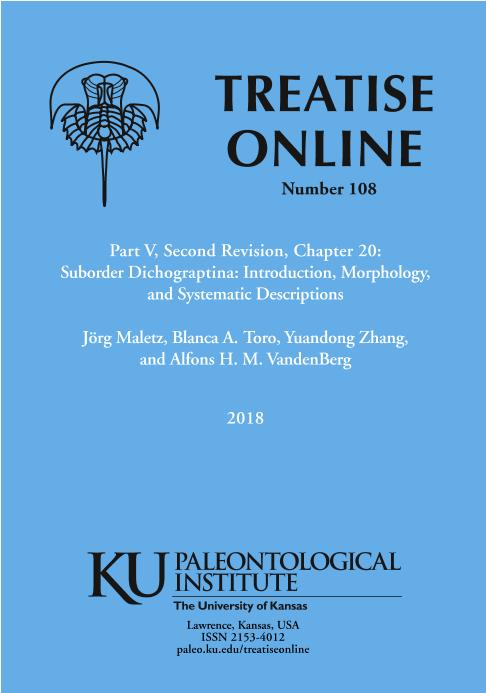Mostrar el registro sencillo del ítem
dc.contributor.author
Maletz, Jörg
dc.contributor.author
Toro, Blanca Azucena

dc.contributor.author
Zhang, Yuandong
dc.contributor.author
VandenBerg, Alfons H. M.
dc.date.available
2021-04-08T20:02:24Z
dc.date.issued
2018-01
dc.identifier.citation
Maletz, Jörg; Toro, Blanca Azucena; Zhang, Yuandong; VandenBerg, Alfons H. M.; Treatise Online no. 108: Part V, Second Revision, Chapter 20: Suborder Dichograptina: Introduction, morphology, and systematic descriptions; Kansas University. Paleontological Institute; Treatise Online; 108; 1-2018; 101-114
dc.identifier.issn
2153-4012
dc.identifier.uri
http://hdl.handle.net/11336/129662
dc.description.abstract
The Suborder Dichograptina includes multiramous to two-stiped graptoloids with biradiate isograptid proximal development and maeandrograptid proximal symmetry; colony shape scandent to reclined, horizontal and pendent; prosicula small, with widening and much larger metasicula; thecae simple widening tubes with or without rutellum; a sicular bitheca may be present in early taxa; branching dichotomous or cladial. Lower Ordovician (upper Tremadocian, Hunnegraptus copiosus Biozone)-Middle Ordovician (upper Darriwiliam, Pterograptus elegans Biozone) worldwide distribution. Dichograptina is one of the two major groups originating of the early plancktic graptolites of the family Anisograptidae. According to Maletz, Carlucci and Mitchell (2009) the Dichograptina and Sinograpta (Sinograptina herein) can be regarded as sister groups. However, Fortey and Cooper (1986) and Lindholm (1991) suggested a polyphyletic origin of derived graptoloids (non bithecate graptoloids) from the Anisograptidae. Thus, the sister group relationship between Anisograptidae and the supercohort Eugraptoloidea (the Graptoloidea of Bulman, 1970) as shown by Maletz, Carlucci and Mitchell (2009) is unlikely to be correct and more research in the transition is needed. Lapworth (1873) understood the Dichograptidae as the group of genera that includes two stiped to multiramous taxa with simple thecae and dichotomous bifurcation or lateral branching. He listed the genera Didymograptus, Tetragraptus, Dichograptus, Loganograptus and Clonograptus. Obut (1957) erected the Suborder Dichograptina for the families Dichograptidae, Tetragraptidae, Bryograptidae and Didymograptidae, essentially confirming the classification of Lapworth (1873) for multiramous or pauciramous Lower to Middle Ordovician graptoloids. However, the name Dichograptina must be credited to Lapworth under the provisions of the ICZN, 1999, Article 36. Bulman (1970) used the term Didymograptina Lapworth, 1880 but included the Nemagraptidae, Dicranograptidae, and Phyllograptidae taxa that are not closely related. The Didymograptina of Bulman (1970) thus is a polyphyletic taxon and not be used. Fortey and Cooper (1986) used the Didymograptina Lapworth, 1873 for the non-virguelated graptoloids and introduced the new term Virgellina forall virgellated graptoloids. They defined the Dichograptina as ?graptoloids lacking bithecae and virgella? (Fortey & Cooper, 1986, p. 640) and referred the two superfamilies Dichograptacea and Glossograptacea to the taxon. Maletz, Carlucci and Mitchell (2009) introduced the supercohort Eugraptoloida as a monophyletic taxon defining all non-bithecate graptoloids. Of these, the stem reclinatids and the Pan-Tetragrapta would be included in the Dichograptina. Maletz (2014) referred four families to the Dichograptina: the Dichograptidae, Didymograptidae, Tetragraptidae, and the virgella-bearing Pterograptidae. He discussed the taxon as a paraphylletic unit with poor internal resolution.
dc.format
application/pdf
dc.language.iso
eng
dc.publisher
Kansas University. Paleontological Institute
dc.rights
info:eu-repo/semantics/openAccess
dc.rights.uri
https://creativecommons.org/licenses/by-nc-sa/2.5/ar/
dc.subject
DICHOGRAPTINA
dc.subject
MORPHOLOGY
dc.subject
SYSTEMATIC
dc.subject.classification
Paleontología

dc.subject.classification
Ciencias de la Tierra y relacionadas con el Medio Ambiente

dc.subject.classification
CIENCIAS NATURALES Y EXACTAS

dc.title
Treatise Online no. 108: Part V, Second Revision, Chapter 20: Suborder Dichograptina: Introduction, morphology, and systematic descriptions
dc.type
info:eu-repo/semantics/article
dc.type
info:ar-repo/semantics/artículo
dc.type
info:eu-repo/semantics/publishedVersion
dc.date.updated
2021-03-26T19:36:57Z
dc.journal.volume
108
dc.journal.pagination
101-114
dc.journal.pais
Estados Unidos

dc.journal.ciudad
Lawrence
dc.description.fil
Fil: Maletz, Jörg. Institut Fur Geologische Wissenschaften, Freie Univers; Alemania
dc.description.fil
Fil: Toro, Blanca Azucena. Consejo Nacional de Investigaciones Científicas y Técnicas. Centro Científico Tecnológico Conicet - Córdoba. Centro de Investigaciones en Ciencias de la Tierra. Universidad Nacional de Córdoba. Facultad de Ciencias Exactas Físicas y Naturales. Centro de Investigaciones en Ciencias de la Tierra; Argentina
dc.description.fil
Fil: Zhang, Yuandong. Chinese Academy of Sciences; China
dc.description.fil
Fil: VandenBerg, Alfons H. M.. Museums Victoria; Australia
dc.journal.title
Treatise Online
dc.relation.alternativeid
info:eu-repo/semantics/altIdentifier/doi/http://dx.doi.org/10.17161/to.v0i0.7736
dc.relation.alternativeid
info:eu-repo/semantics/altIdentifier/url/https://journals.ku.edu/treatiseonline/article/view/7736
Archivos asociados
